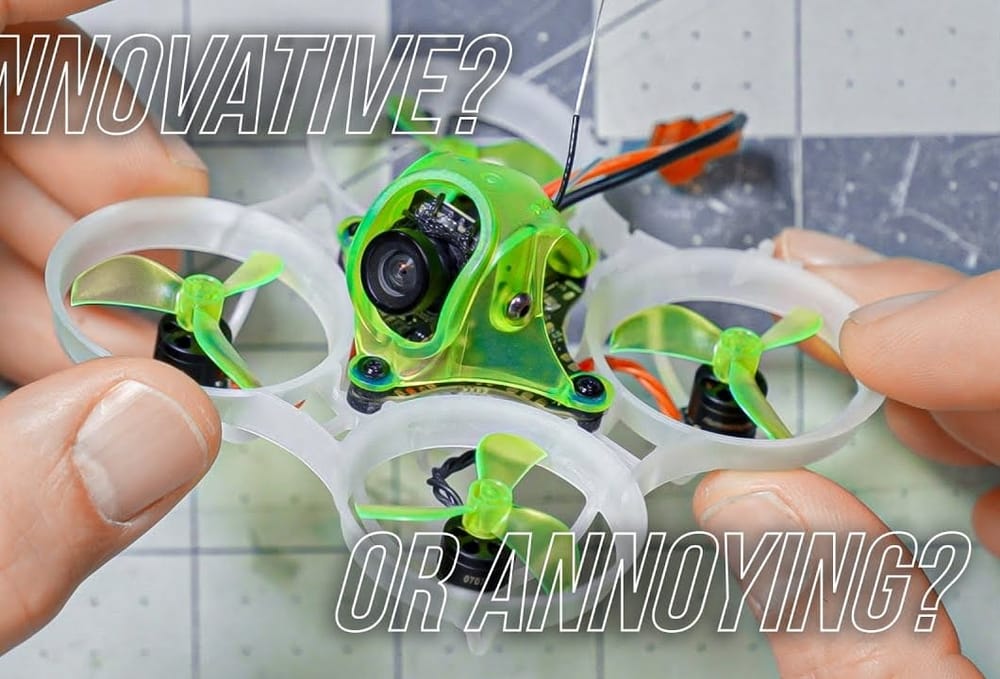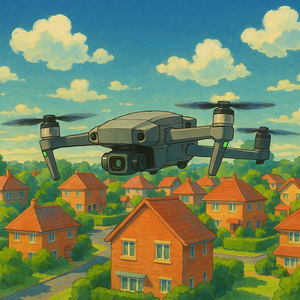The NewBeeDrone Hummingbird V4 is a budget 65mm whoop that promises decent flight performance with a handful of design quirks. For £80, it’s tempting—but does it live up to expectations or just add head-scratching compromises? Here’s a clear-eyed assessment.
Familiar Frame, Different Flavour
The Hummingbird V4 looks like your typical 65mm whoop, similar to offerings from BetaFPV or Happymodel. But NewBeeDrone has a history of taking the road less travelled with some unusual design choices. The drone uses the NewBeeDrone Cockroach frame, a durable and well-regarded chassis that has reportedly come with a lifetime warranty in the past. After a week of crashes, the frame held up fine, though its long-term toughness remains unproven.

Motors: 0702 Size, 30,000KV—Too Much of a Good Thing?
The motors are the standard 0702 size, which is widely accepted among top 65mm whoop pilots. However, the 30,000KV rating raises an eyebrow. Higher KV means more power and responsiveness, but it also puts more strain on props and batteries, reducing flight time. Some pilots push this even higher, up to 40,000KV, for maximum punch.
Despite reservations, the Hummingbird V4 flies well and delivers a respectable three minutes of flight time using premium NitroNector Gold 300mAh batteries with high-performance square cells. These batteries cost two to three times more than typical alternatives but outperform them significantly.
For those wanting longer flight times, Betaflight’s motor output limit lets you dial down the effective KV in software without hardware changes. This means the V4 offers high performance out of the box, with the option to tone it down for gentler flying.

Custom Flight Controller Packs Features
The heart of the Hummingbird V4 is its custom-built flight controller. It sports a built-in ExpressLRS receiver and a 400mW analog video transmitter—up from 25mW in the previous version, which was fine for racing but weak for cruising or freestyle flying. The jump to 400mW boosts range and signal reliability.
The flight controller also includes a 4-channel, 12A ESC—more than enough for a 65mm whoop, where 5-6A ESCs are more common. Both the receiver and video transmitter antennas use U.FL connectors, not direct solder, making antenna replacement straightforward without fiddly soldering.
The drone weighs 19.3 grams without battery—light but not ultra-light. High-performance racers hover around 16-17 grams, but this weight is perfectly fine for fun flight.

Flight Performance: Racing and Freestyle
In a basement race setup, the Hummingbird V4 performed well. The pilot got comfortable flying acro mode within a few packs, showing good handling and responsiveness. While not the absolute fastest or lightest, it was solid and enjoyable.
Freestyle flying indoors proved more challenging. The pilot struggled a bit with typical whoop quirks but managed flips, rolls, and even attempted power loops. The drone handled these well enough for a beginner to intermediate flyer.

The First Head-Scratcher: PH 2.0 Battery Connector
Despite many modern standards, the Hummingbird V4 uses a PH 2.0 battery connector. While a good quality connector with solid plastic, PH 2.0 is known for higher electrical resistance, causing voltage sag and power loss under load.
Today’s standard connectors are BT 2.0 or A30, which offer lower resistance and better performance. BT 2.0 requires licensing fees paid to BetaFPV, which might explain NewBeeDrone’s reluctance. A30 is an open standard and compatible with many batteries, making it a better choice.
The voltage sag was noticeable but manageable thanks to the excellent batteries. Flight time hovered around three minutes, typical for 1S 300mAh packs run to their limit. Still, better connectors could have squeezed more power and flight time out.

Motor Connectors: Proprietary and Painful
NewBeeDrone uses unique, smaller motor connectors. While this saves PCB space, it complicates repairs and upgrades. Motors from other brands won’t plug and play; you must direct solder them. This is a hassle for pilots wanting to swap parts easily.
The flight controller does provide solder pads, allowing motor wire repairs if needed. This is a useful feature, but the proprietary plug choice adds friction to maintenance.

Outdoor Flight and Video Transmitter Range
Despite being an indoor whoop, the Hummingbird V4 surprised by flying well outdoors. Increasing the video transmitter power to 400mW showed strong signal range, with ExpressLRS link holding solid even behind obstructions. Many whoops lose video feed sooner, but this one maintained a decent picture.
The camera, however, is the drone’s weak point. The image is muddy with blown-out highlights and inconsistent exposure. While analog cameras have limitations, this one underdelivers on detail and clarity compared to better whoop cams.

Camera Angle Adjustment: A Double-Edged Sword
The Hummingbird V4 allows camera angle adjustment, a feature absent on the previous fixed-angle version. This lets pilots tweak the camera tilt to suit their flying style. However, the mechanism doesn’t hold up well in crashes, resulting in the camera tilting downwards.
This inconsistency forces careful flying or manual adjustment after every crash. There’s no perfect solution yet, but this is a notable annoyance for pilots seeking consistent visuals.

Interview with NewBeeDrone Owner Kelvin Lee: Explaining the Oddities
Kelvin Lee, NewBeeDrone’s owner, sheds light on the drone’s peculiar design choices. The Hummingbird V3 had oscillator issues causing ExpressLRS receiver failures and short range. This was due to a Chinese oscillator component supplied in bulk, where a significant portion was defective. NewBeeDrone takes responsibility, offering refunds or replacements for affected units.
Regarding proprietary choices like the custom OSD chip, motor plugs, and SPI-based ExpressLRS receiver, Kelvin explains these stem from the cramped PCB space. They use tiny 0201 components and custom firmware to pack features into a small board. This approach took two years of development and a dedicated embedded engineer.
This trailblazing mindset aims to solve problems innovatively, though imperfectly. Customers annoyed by proprietary quirks can choose other products, but those valuing NewBeeDrone’s approach have a unique offering.

Firmware and Customer Support Philosophy
NewBeeDrone provides custom Betaflight firmware pre-tuned and baked into the flight controller’s EEPROM. This lets customers reset to factory settings with a simple button press, avoiding the usual Betaflight default reset that often breaks bind-and-fly drones.
Kelvin emphasizes this reduces customer support calls and user frustration, especially for beginners unfamiliar with DFU mode or CLI dumps. While this locks users into NewBeeDrone’s firmware ecosystem, it simplifies recovery and support.

Why Not BT 2.0 or A30 Connectors?
Kelvin admits BT 2.0 is off the table due to licensing fees paid to BetaFPV, which NewBeeDrone wants to avoid. Instead, they’re developing a new NX69 connector and battery that promises 30% better performance than BT 2.0.
This new connector is backwards compatible with existing PH 2.0 batteries, easing transition. While initially it looks like just another proprietary standard, compatibility and performance gains might justify the choice.

Final Verdict: Good Whoop, But Shop Around
The NewBeeDrone Hummingbird V4 is a solid beginner whoop. It flies well, offers decent range and power, and is reasonably durable. The camera is the weakest link, but still usable.
At £80, it’s a good value, especially given the premium batteries and built-in ExpressLRS with a powerful video transmitter. However, the PH 2.0 battery connector and proprietary motor plugs may annoy some.
Before buying, consider alternatives like the BetaFPV Air 65 or Happymodel Mobula Lite. They offer better cameras and sometimes lighter builds. Also, if you want HD video, check out HDZero whoops like the Mobula 6 HD.
For shopping tips, see this beginner-friendly FPV drones guide and how to choose the best motor for your drone.
Takeaway Box
- NewBeeDrone Hummingbird V4 flies well and is durable, but uses quirky proprietary parts.
- 30,000KV motors deliver punchy flight but strain batteries; software limits help dial it down.
- PH 2.0 battery connector causes voltage sag; NX69 connector coming to improve performance.
- Camera quality is mediocre—adequate but not impressive.
- Custom firmware simplifies resets but locks you into NewBeeDrone’s ecosystem.
This article was based from the video $80 Whoop ... with compromises. Worth it? // NEWBEEDRONE HUMMINGBIRD V4




